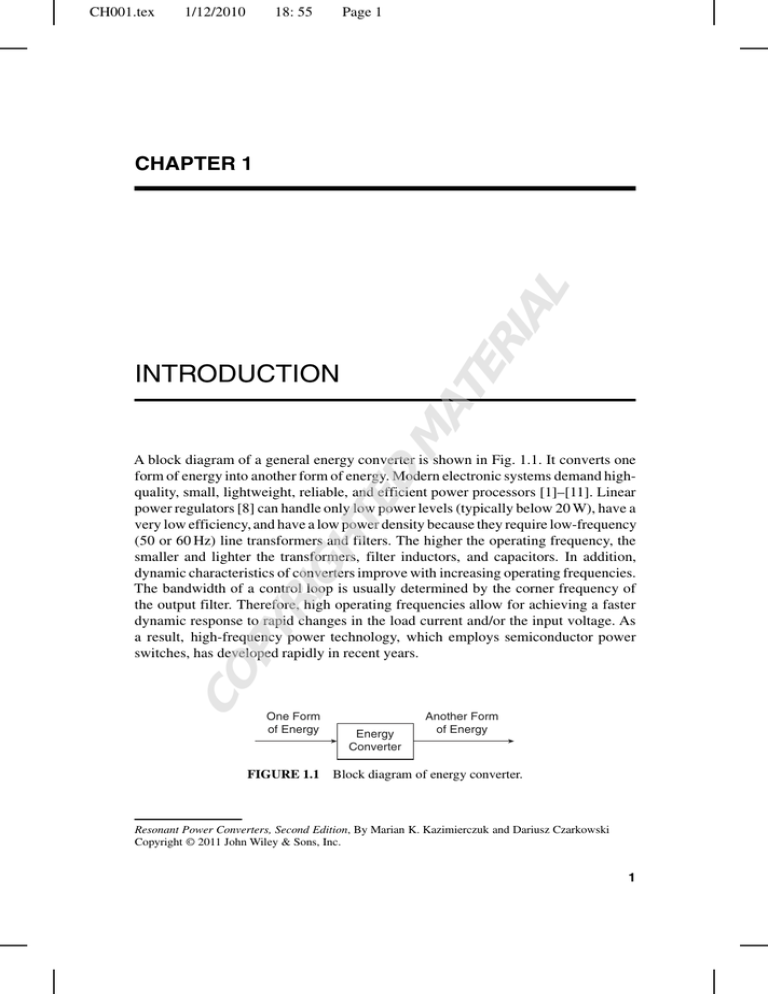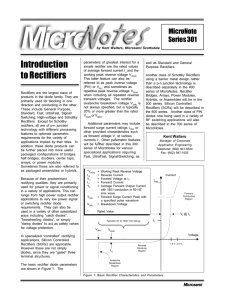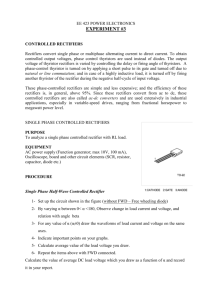copyrighted material - beck
advertisement

CH001.tex 1/12/2010 18: 55 Page 1 RI AL CHAPTER 1 MA TE INTRODUCTION CO PY RI GH TE D A block diagram of a general energy converter is shown in Fig. 1.1. It converts one form of energy into another form of energy. Modern electronic systems demand highquality, small, lightweight, reliable, and efficient power processors [1]–[11]. Linear power regulators [8] can handle only low power levels (typically below 20 W), have a very low efficiency, and have a low power density because they require low-frequency (50 or 60 Hz) line transformers and filters. The higher the operating frequency, the smaller and lighter the transformers, filter inductors, and capacitors. In addition, dynamic characteristics of converters improve with increasing operating frequencies. The bandwidth of a control loop is usually determined by the corner frequency of the output filter. Therefore, high operating frequencies allow for achieving a faster dynamic response to rapid changes in the load current and/or the input voltage. As a result, high-frequency power technology, which employs semiconductor power switches, has developed rapidly in recent years. One Form of Energy Energy Converter Another Form of Energy FIGURE 1.1 Block diagram of energy converter. Resonant Power Converters, Second Edition, By Marian K. Kazimierczuk and Dariusz Czarkowski Copyright © 2011 John Wiley & Sons, Inc. 1 CH001.tex 2 1/12/2010 18: 55 Page 2 INTRODUCTION High-frequency power processors can be classified into three categories: • • • Inverters (DC-AC converters) Rectifiers (AC-DC converters) DC-DC converters DC-AC inverters, whose block diagram is depicted in Fig. 1.2(a), convert DC energy into AC energy. The input power source is either a DC voltage source or a DC current source. Inverters deliver AC power to a load impedance. In many applications, a sinusoidal output voltage or current is required. To generate a sinusoidal voltage and/or current waveforms, DC-AC inverters contain a resonant circuit; therefore, they are called resonant DC-AC inverters. Power MOSFETs are usually used as switching devices in resonant inverters at high frequencies and in isolated-gate bipolar transistors (IGBTs) and MOS-controlled thyristors (MCTs) at low frequencies. A block diagram of an AC-DC rectifier is depicted in Fig. 1.2(b). Rectifiers convert an AC voltage or current into a DC voltage. At low frequencies of 50, 60, and 400 Hz, peak rectifiers are widely used; however, the ratio of the diode peak current to the diode average current is very high in these rectifiers, and the diode current waveforms contain a large amount of harmonics. Therefore, peak rectifiers are not used at high frequencies. In this book, rectifiers suitable for high-frequency applications are given and analyzed. High-frequency rectifiers can be divided into unregulated diode rectifiers, unregulated synchronous rectifiers, and regulated synchronous rectifiers. Both pn junction diodes and Schottky diodes are used in the first group of circuits. Silicon Schottky diodes are used only in low-output voltage applications because their breakdown voltage is relatively low, typically less than 100 V. They have low forward DC Inverter AC (a) AC Rectifier DC (b) DC Inverter AC Rectifier DC (c) FIGURE 1.2 Block diagrams of high-frequency power processors. (a) Inverters (DC-AC converters). (b) Rectifiers (AC-DC converters). (c) DC-DC converters. CH001.tex 1/12/2010 18: 55 Page 3 INTRODUCTION 3 voltage drops of the order of 0.3 to 0.4 V and do not suffer from reverse recovery, resulting in high rectifier efficiency. The leakage current in Schottky diodes is much higher than that in junction diodes. When the peak value of the diode voltage exceeds 100 V, pn junction diodes or silicon carbide diodes [9] must be used. Power pn junction diodes have a forward voltage drop of about 1 V and a reverse recovery effect that limits the operating frequency of rectifiers. Schottky diodes do not suffer from reverse-recovery effects and are suitable for high-frequency applications. In both unregulated and regulated synchronous rectifiers, power MOSFETs are used. Unlike diodes, power MOSFETs do not have an offset voltage. If their onresistance is low, the forward voltage drops are low, yielding high efficiency. High-frequency power processors are used in DC-DC power conversion. A block diagram of a DC-DC converter is shown in Fig. 1.2(c). The functions of DC-DC converters are as follows: • • • • • • To convert a DC input voltage VI into a DC output voltage VO ; To regulate the DC output voltage against load and line variations; To reduce the AC voltage ripple on the DC output voltage below the required level; To provide isolation between the input source and the load (isolation is not always required); To protect the supplied system from electromagnetic interference (EMI); To satisfy various international and national safety standards. Pulse-width modulated (PWM) converters [1]–[9] are well described in the literature and are still widely used in low- and medium-power applications. However, PWM rectangular voltage and current waveforms cause turn-on and turn-off losses that limit the operating frequency. Rectangular waveforms generate broad-band electromagnetic energy and thus increase the potential for electromagnetic interference (EMI). The inability of PWM converters to operate efficiently at very high frequencies imposes a limit on the size of reactive components of the converter and, thereby, on power density. In search of converters capable of operating at higher frequencies, power electronics engineers started to develop converter topologies that shape either a sinusoidal current or a sinusoidal voltage waveform, significantly reducing switching losses. The key idea is to use a resonant circuit with a sufficiently high quality factor. Such converters are called resonant DC-DC converters. In many resonant DC-DC converters, transistors and diodes operate under soft-switching conditions, either zero-voltage switching (ZVS) or zero-current switching (ZCS). These kind of waveforms reduce switching losses and EMI levels. A resonant DC-DC converter is obtained by cascading a resonant DC-AC inverter and a high-frequency rectifier, as shown in Fig. 1.2(c). The DC input power is first converted into AC power by the inverter, and then the AC power is converted back to DC power by the rectifier. If isolation is required, a high-frequency transformer, which is much smaller than a low-frequency transformer, can be inserted between the inverter and the rectifier. CH001.tex 4 1/12/2010 18: 55 Page 4 INTRODUCTION The cascaded representation of a resonant DC-DC converter is convenient from an analytical point of view. If the input current or the input voltage of the rectifier is sinusoidal, only the power of the fundamental component is converted from AC to DC power. In this case, the rectifier can be replaced by the input impedance, defined as the ratio of the fundamental components of the input voltage to the input current. In turn, the input impedance of the rectifier can be used as an AC load of the inverter. Thus, the inverter can be analyzed and designed as a separate stage, independently of the rectifier. If the loaded quality factor of a resonant circuit is high enough and the switching frequency is close enough to the resonant frequency, a resonant inverter usually operates in continuous conduction mode and forces either a sinusoidal output current or a sinusoidal output voltage, depending on the resonant circuit topology. Therefore, the entire inverter can be replaced by a sinusoidal current source or a sinusoidal voltage source that drives the rectifier. As a result, the analysis and design of the rectifier can be carried out independent of the inverter. Finally, the two stages— the inverter and the rectifier—can be cascaded, in a manner similar to other cells in electronic systems. The cascaded inverter and rectifier should be compatible. A rectifier that requires an input voltage source (called a voltage-driven rectifier or a voltage-source rectifier) should be connected to an inverter whose output behaves like a voltage source. This takes place in inverters that contain a parallel-resonant circuit. Similarly, a rectifier that requires an input current source should be connected to an inverter whose output behaves like a current source. A rectifier that requires an input current source (called a current-driven rectifier or a current-source rectifier) should be connected to an inverter whose output behaves like a current source. Inverters that contain a series-resonant circuit force a sinusoidal output current. Characteristics of a DC-DC converter, for example, efficiency or voltage transfer function, can be obtained simply as a product of characteristics of an inverter and a rectifier. For example, nine converters can be built by using three types of inverters and three types of rectifiers, assuming that the inverters and rectifiers are compatible. To obtain characteristics of all converters with the state-space approach, a tedious analysis of nine complex circuits is required and the results are given in the form of graphs rather than equations. In addition, the entire analysis must be repeated with every change of the converter topology. In contrast, the cascaded representation allows one to obtain characteristics of nine converters from the analysis of only six simple blocks (three inverters and three rectifiers). Moreover, the results are given as closed-form expressions, which makes it easier to investigate effects of various parameters on the converter performance. Because of its advantages, the fundamental-frequency approach outlined above is used throughout this book. If the loaded quality factor of the resonant circuit is very low and/or the switching frequency is much lower or much higher than the resonant frequency, the current and voltage waveforms may significantly differ from sine waves. The converter may even enter a discontinuous conduction mode. In such cases, the state-space analysis should be used. CH001.tex 1/12/2010 18: 55 Page 5 1.1 REFERENCES 5 1.1 REFERENCES 1. R. P. Severns and G. Bloom, Modern DC-to-DC Switchmode Power Converter Circuits, New York: Van Nostrand Reinhold, 1985. 2. R. G. Hoft, Semiconductor Power Electronics, New York: Van Nostrand Reinhold, 1986. 3. J. G. Kassakian, M. S. Schlecht, and G. C. Verghese, Principles of Power Electronics, Reading, MA: Addison-Wesley, 1991. 4. N. Mohan, T. M. Undeland, and W. P. Robbins, Power Electronics: Converters, Applications and Design, 3rd Ed. Hoboken, NJ: John Wiley & Sons, 2003. 5. M. H. Rashid, Power Electronics, 3rd Ed. Upper Saddle River, NJ: Prentice Hall, 2004. 6. R. W. Erickson and D. Maksimović, Fundamentals of Power Electronics, 2nd Ed. Norwall, MA: Kluwer Academic, 2001. 7. I. Batarseh, Power Electronic Circuits, Hoboken, NJ: John Wiley & Sons, 2004. 8. M. K. Kazimierczuk, Electronic Devices, A Design Approach, Upper Saddle River, NJ: Prentice Hall, 2004. 9. M. K. Kazimierczuk, Pulse-Width Modulated DC-DC Power Converters, Chichester, UK: John Wiley & Sons, 2008. 10. M. K. Kazimierczuk, High-Frequency Magnetic Components, Chichester, UK: John Wiley & Sons, 2008. 11. M. K. Kazimierczuk, RF Power Amplifiers, Chichester, UK: John Wiley & Sons, 2008. CH001.tex 1/12/2010 18: 55 Page 6




